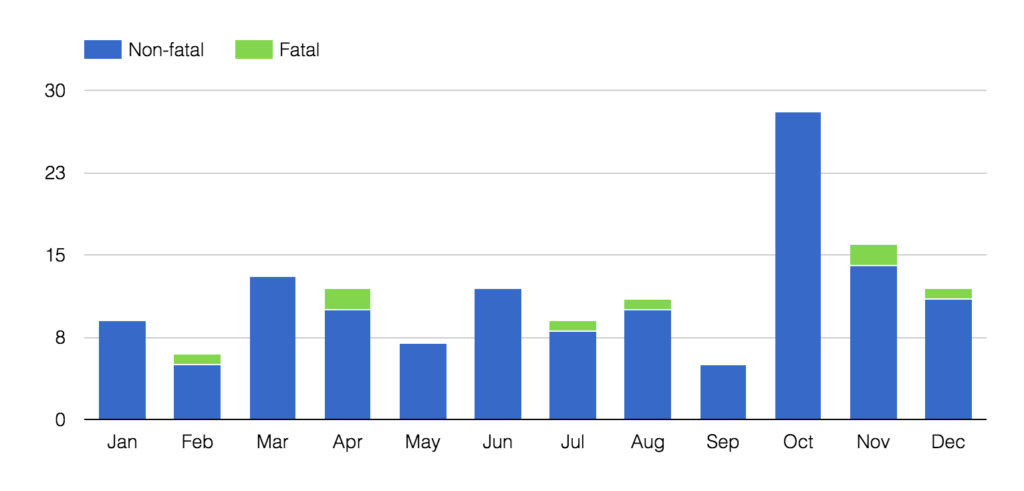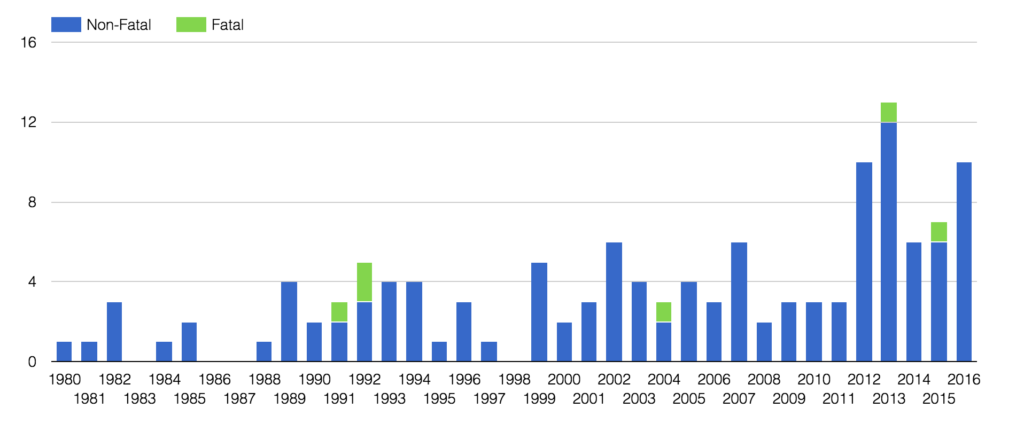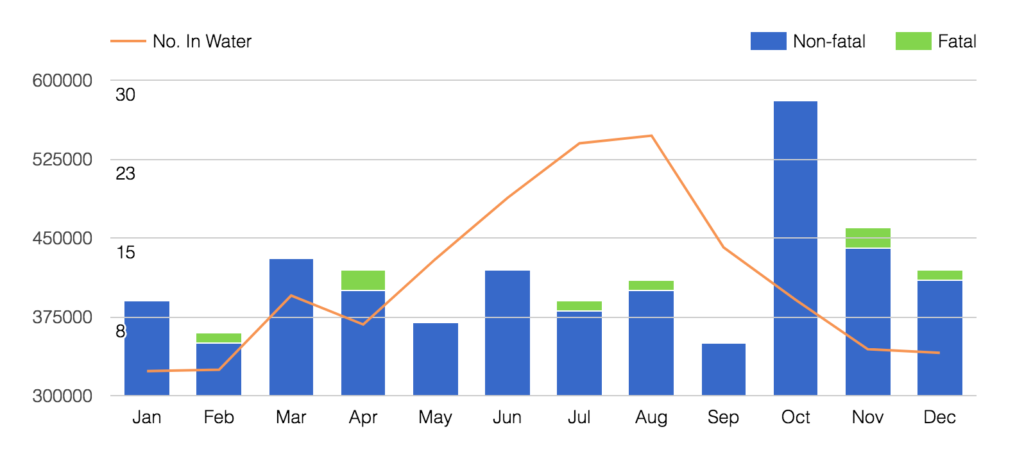DAR: October Sees Greatest Number of Shark Bites

GRAPHIC: INCIDENTS BY MONTH – 1980-2016
“Pua ka wiliwili, nanahu ka manō. (When the wiliwili tree blooms, the shark bites)” – ‘Ōlelo No‘eau *Hawaiian Proverbs & Poetical Sayings, Mary Kawena Pukui, 1983
GRAPHIC: INCIDENTS BY MONTH – 1980-2016 This graphic depicts only confirmed unprovoked incidents, defined by the International Shark Attack File as “incidents where an attack on a live human by a shark occurs in its natural habitat without human provocation of the shark. Incidents involving…shark-inflicted scavenge damage to already dead humans (most often drowning victims), attacks on boats, and provoked incidents occurring in or out of the water are not considered unprovoked attacks.” Image source: Courtesy of Division of Aquatic Resources, Hawaiʻi Department of Land and Natural Resources
Officials with the state Department of Land and Natural Resources say that for centuries, traditional Hawaiian chants have warned about an increased risk of shark bites in the fall, when the wiliwili tree blooms.
Today, that warning still applies, according to Division of Aquatic Resources administrators.
“October is the month with the greatest number of shark bites,” said DAR Administrator Bruce Anderson. “We recommend ocean users exercise a little more caution this month especially, and also through the end of the year. The chance of being bitten by a shark in Hawaiian waters is always extremely small, but does increase a bit during this time frame.”

GRAPHIC: INCIDENTS BY YEAR – 1980-2016
GRAPHIC: INCIDENTS BY YEAR – 1980-2016 This graphic depicts only confirmed unprovoked incidents, defined by the International Shark Attack File as “incidents where an attack on a live human by a shark occurs in its natural habitat without human provocation of the shark. Incidents involving…shark-inflicted scavenge damage to already dead humans (most often drowning victims), attacks on boats, and provoked incidents occurring in or out of the water are not considered unprovoked attacks.” Image source: Courtesy of Division of Aquatic Resources, Hawaiʻi Department of Land and Natural Resources

GRAPHIC: INCIDENTS BY ACTIVITY – 1950-2016
GRAPHIC: INCIDENTS BY ACTIVITY – 1950-2016 This graphic includes both provoked and unprovoked incidents in which shark involvement was confirmed. Provoked incidents are defined by the International Shark Attack File as occurring “when a human initiates physical contact with a shark, e.g. a diver bit after grabbing a shark, a fisher bit while removing a shark from a net, and attacks on spearfishers and those feeding sharks.” Unprovoked incidents are those “where an attack on a live human by a shark occurs in its natural habitat without human provocation of the shark. Incidents involving…shark-inflicted scavenge damage to already dead humans (most often drowning victims), attacks on boats, and provoked incidents occurring in or out of the water are not considered unprovoked attacks.” Image source: Courtesy of Division of Aquatic Resources, Hawaiʻi Department of Land and Natural Resources
So far this year in Hawai‘i, one shark bite incident was reported on April 14, 2017,on Kaua‘i in Kekaha at Davidsons Beach approximately 120 yards from shore. The surfer recieved severe injuries to the lower right leg from a 9–12-foot Tiger shark in 5–10 feet of water.
No shark bites were reported on Maui yet this year, although some close calls were reported.
Kama‘ole Beach Park I and Kama‘ole Beach Park III was closed due to a shark incident that occurred at around 12:30 p.m. Thursday, Oct. 5, 2017. A 40-year-old female visitor from Canada was snorkeling about 10 yards off of the point between Kama‘ole II and Kama‘ole III when she was bumped by what is described as an 8-foot grey shark. The woman suffered minor abrasions to her left thigh and left arm and declined medical treatment.
Another close encounter occurred on Tuesday, Oct. 3, 2017, at Mākena State Park, when a man and woman spearfishing about 100 yards from shore on the north end of Big Beach were approached by an 8- to 10-foot Galapagos shark displaying aggressive behavior. The shark circled the freedivers and their dive float, and eventually took their catch of fish. There were no injuries reported, and the beach was closed for two hours.
That was the second shark sighting at Mākena within a two-week span. Another incident was reported on Sept. 21 after an aggressive shark stole the fish catch of two men spearfishing offshore. The fisherman in that incident said they believed the shark to be a seven-foot Galapagos shark.

GRAPHIC: INCIDENTS VS. PEOPLE IN WATER
GRAPHIC: INCIDENTS VS. PEOPLE IN WATER Number in water (Y1 axis) based on O’ahu swimmer and surfer counts, monthly averages 1998-99, Honolulu Ocean Safety Division data. Number of incidents (Y2 axis) based on statewide shark data 1950-2016. The relationship between number of people in the water and number of shark bites is not always as expected. There appears to be an increased risk of being bitten by a shark during certain months, in particular October through December. Early Hawaiians recognized this, and cautioned against going in the water at that time. Although fewer people are in the water from Nov-Dec, some of Hawaii’s most serious shark attacks took place during those months. Analysis of weather/ocean conditions and tiger shark life history is beginning to shed some light on the patterns shown in this graph. Image source: Courtesy of Division of Aquatic Resources, Hawaiʻi Department of Land and Natural Resources
University of Hawai‘i researchers, funded in part by DAR, have confirmed the fall spike, and offered a partial possible explanation.
“About 25% of the female tiger sharks in the Northwestern Hawaiian Islands migrate to the main islands in the fall to give birth,” DLNR officials noted. “The increased number of sharks in near shore waters, combined with their need to feed to replenish lost energy stores, may increase the likelihood of a bad encounter with a human,”
DAR officials said, the best thing ocean users can do to minimize their risk of shark bites is to utilize beaches with lifeguards, stay near other people and don’t go too far from shore. Also, avoid murky water and areas near stream mouths.
More safety tips can be found at the Division’s shark website.
Below is a list of reported shark bite incidents off of Maui since 2013:
7 Maui Shark Bite Incidents in 2016:
Nov. 14, 2016, 10 a.m.: While treading water, a swimmer received multiple lacerations to right leg from a 15-foot-long unknown species of shark in clear water 30 yard offshore Kama‘ole Beach Park i in Kīhei.
Oct. 21, 2016, 4:50 p.m.: A surfer suffered lacerations to left arm, hand and leg from an unknown species of shark in 6–8-foot deep water 100 yards from shore at Ho‘okipa Beach Park, Pā‘ia.
Oct. 14, 2016, 9:50 a.m.: A swimmer received severe, deep lacerations to lower left leg, minor lacerations to left foot from a 7-foot-long shark of undetermined species at Kama‘ole Beach Park I in Kīhei, 40–60 yards off shore.
Aug. 6, 2016, 4:30 p.m.: Maui stand-up paddleboarder, Connor Baxter was using a SUP hydrofoil when the long foil attached to his SUP board was bit by a tiger shark, estimated to be 10 feet long. The incident was reported in the Hamakuapoko area of Pā‘ia, about one mile from shore. DLNR officials say the incident occurred in 40-50 feet of water that was described as being turbid.
May 3, 2016, 3:50 p.m.: A 59-year-old man suffered minor lacerations to his right shoulder while floating in waters off of Wailea Beach about 40 yards from shore in 15-20 feet of turbid water. The species and length of the shark is unknown.
March 31, 2016, 11 a.m.: A 46-year old female visitor was snorkeling with a commercial tour when a shark bit her snorkel fin. The incident occurred in Olowalu, approximately 400-450 yards from shore in 15-20 feet of turbid water. (J. Orr). Authorities say the woman sustained a minor laceration to left foot. The shark was described as a tiger shark, measuring approximately 8 feet long.
Jan. 23, 2016, 10:30 a.m.: Wailea Beach Point, 150-200 yards from shore. A 10-12 foot shark bit the tail of a paddleboard being operated by a stand-up paddleboarder in 30 feet of water during clear conditions. The shark was a 10-12 foot Tiger shark.
3 Maui Shark Bite Incidents in 2015:
Oct. 31, 2015, 3:30 p.m.: Lāna‘i, Po‘aīwa Beach, approx 300 yards from shore Spearfishing Turbid est 25 ft Confidential. No injury; shark bit weight belt. Considered a provoked incident due to activity. Tiger shark, length 10-12 feet.
April 29, 2015, est. 8:30 a.m. ʻĀhihi Kīnaʻu Bay, Kanahena Point, approx 200 yards from shore Snorkeling Turbid 20-35 ft M. Cruse. Fatal. Severe deep lacerations to right shoulder and underarm; minor lacerations to right arm and right side of face. Species and length unknown.
Jan. 27, 2015, 3:30 a.m.: Maui, Pali scenic lookout Fishing Turbid on shore M. Pollard. Lacerations to left calf. Considered a provoked incident due to activity. Reef shark, species unknown, length 4 feet.
5 Maui Shark Bite Incidents in 2014:
Nov. 13, 2014: A 50 year old Homer, Alaska man, snorkeling in the ocean off of Kahekili “Airport” Beach in the Kāʻanapali area of West Maui, reported being bitten by a shark at around 1:30 p.m. on Thursday, Nov. 13, 2014.
Oct. 22, 2014: A Kīhei woman who was standup paddle boarding approximately 200 yards offshore in 6 feet of water at Waipuʻilani Beach Park reported that a tiger shark knocked her into the water and bit the tail portion of her board.
Oct. 20, 2014: a 58-year-old man was stand up paddle boarding at Kahului Harbor when a shark reportedly bit the man’s board.
Oct. 18, 2014: a surfer fended off a shark attack at Māʻalaea. In that incident, park officials say a 12 to 14 foot shark bit the man’s board.
July 16, 2014: 5:20 p.m. at Pāʻia Bay, 200-250 yards from shore in 15 to 20 feet of water. A swimmer reported being bitten by a 6 to 7 foot reef shark and sustained lacerations to his left foot.
8 Maui Shark Bite Incidents in 2013:
Dec. 2, 2013: 10:20 a.m. in Mākena, approximately 900 yards from shore in about 100 feet of water. A man who was fishing from a kayak died after sustaining a severe deep laceration and loss of tissue on right calf. State officials say they consider the encounter a provoked incident due to activity. The species and length of the shark is unknown.
Nov. 29, 2013: 1 p.m. in Kīhei at Keawakapu, approximately 30-40 yards from shore in 10 to 15 feet of water. A snorkeler sustained a severe laceration to their right inner calf, as well as minor lacerations and puncture wounds to the right shin and ankle. State officials say the species and length of the shark is unknown.
Oct. 31, 2013, at Ka’a Point in Central Maui: A kite surfer suffered injuries to his right leg and calf in an apparent shark attack incident about 300 yards offshore.
Oct. 23, 2013, off of Kukona Place in Waiehu: Shane Mills of Maui suffered a laceration to his lower back and left thigh in an apparent shark bite incident.
Aug. 14, 2013, at Palauea Beach, also known as White Rock in Māken: Jana Lutteropp, a 20-year-old German woman had her arm severed in a shark attack incident and died a week later on Wednesday, Aug. 21.
July 31, 2013, at Ulua Beach in Wailea: Evonne Cashman of California suffered puncture wounds to both surfaces of right side of torso and lacerations to right hand while swimming approximately 125 yards from shore.
April 2, 2013, 8:20 a.m. at Kā’anapali, Honokōwai: A surfer reportedly suffered lacerations to their right leg after an encounter with a reef shark approx 100 yards from shore in six feet of water, according to state data.
Feb. 21, 2013, at Pāʻia Bay: A reef shark reportedly bit the rail of a foam surfboard while J. Lansky was surfing approximately 75 yards from shore in 5 to 8 feet of water, according to the state data.
The Hawaii Sharks website is used to document confirmed shark encounters, and “does not include encounters in which a shark does not actually bite a person or board, nor incidents classified by the International Shark Attack File as boat attacks, scavenge, or doubtful.”
*Supporting information courtesy: State Department of Land and Natural Resources.

Whitetip shark
Photographer credit: Jim Abernethy










